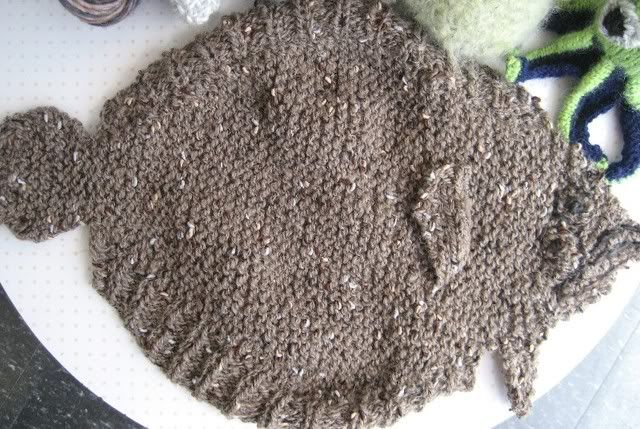
With their portly blue heads and gaping toothy maw, it has been said that only a
wolf fish could love another wolf fish. Their peculiar skin lacks scales, and casts a green, blue, or even purplish hue (though this flamboyant colouring quickly fades when brought to the surface). However, it has also been
said that the best habitat for a wolf is in the human heart, and you can see that this adorable crocheted version was crafted with love.
Three species of wolf fish occur in Atlantic Canadian waters: northern wolf fish (Anarhichas denticulatus), spotted wolf fish (Anarhichas minor), and Atlantic wolf fish (Anarhichas lupus). Lone wolves of the sea, these fish enjoy a mostly solitary life, making their homes in deep rocky outcroppings, where they chow down on mollusks, crustaceans, echinoderms, and other crunchy sea floor fauna with their powerful canine-like teeth.
 While wolf fish are not targeted by fishermen, all three species experienced serious population declines during the 1980s and 1990s. Bottom trawls damage spawning habitat by disturbing the rocky structure they use for shelter and nesting,
While wolf fish are not targeted by fishermen, all three species experienced serious population declines during the 1980s and 1990s. Bottom trawls damage spawning habitat by disturbing the rocky structure they use for shelter and nesting, and they are often caught as by-catch. Canada's Species at Risk Act (SARA) lists the northern and spotted wolf fish as threatened and the Atlantic or striped wolf fish as special concern. SARA makes it illegal to harm these vulnerable creatures, but for now, a special DFO "allowable harm assessment" allows fishermen to land and sell some wolf fish.
and they are often caught as by-catch. Canada's Species at Risk Act (SARA) lists the northern and spotted wolf fish as threatened and the Atlantic or striped wolf fish as special concern. SARA makes it illegal to harm these vulnerable creatures, but for now, a special DFO "allowable harm assessment" allows fishermen to land and sell some wolf fish.
Most wolf fish on the market is landed incidentally by otter trawls targeting haddock or greenland halibut. It is popular in UK fish and chip shops where it is often sold as Scotch halibut, lobo or woof. Here in Atlantic Canada, it more likely to be marketed as leopardfish, Atlantic catfish, or simply, catfish. Unfortunately, lax labeling laws in Canada currently make it difficult for consumers to make sustainable seafood choices. If you see catfish on offer at your local fish counter, make sure to ask for the species name along with how and where it was caught... or you might end up eating an endangered species for supper.

 With their portly blue heads and gaping toothy maw, it has been said that only a wolf fish could love another wolf fish. Their peculiar skin lacks scales, and casts a green, blue, or even purplish hue (though this flamboyant colouring quickly fades when brought to the surface). However, it has also been said that the best habitat for a wolf is in the human heart, and you can see that this adorable crocheted version was crafted with love.
With their portly blue heads and gaping toothy maw, it has been said that only a wolf fish could love another wolf fish. Their peculiar skin lacks scales, and casts a green, blue, or even purplish hue (though this flamboyant colouring quickly fades when brought to the surface). However, it has also been said that the best habitat for a wolf is in the human heart, and you can see that this adorable crocheted version was crafted with love.  While wolf fish are not targeted by fishermen, all three species experienced serious population declines during the 1980s and 1990s. Bottom trawls damage spawning habitat by disturbing the rocky structure they use for shelter and nesting,
While wolf fish are not targeted by fishermen, all three species experienced serious population declines during the 1980s and 1990s. Bottom trawls damage spawning habitat by disturbing the rocky structure they use for shelter and nesting, and they are often caught as by-catch.
and they are often caught as by-catch. 






















